



Table of Contents: 2016 JULY–AUGUST No. 411
Hutcherson L. My NCBI — Institute of Education Sciences Biographical Sketch in SciENcv. NLM Tech Bull. 2016 Jul-Aug;(411):e5.
SciENcv users can now create biosketches in the Institute of Education Sciences (IES) biographical sketch format which can be used to apply for IES funding. In addition, users can also export their citations from the IES Education Resources Information Center (ERIC) database to My Bibliography. This newly added biosketch format is available to download in PDF, MS Word or XML, and users are able to share their SciENcv IES biosketches through a public URL.
The IES biographical sketch consists of five sections:
Creating SciENcv Profiles Using the IES Biographical Sketch Format
There are three ways to create a SciENcv profile in the IES biographical sketch format: entering information manually, copying information from an existing SciENcv biosketch, or using an external data source to populate a biosketch.
For the manual option, assign a Biosketch name to the new profile, select the IES Biosketch format option, select "Start with a blank document," choose a Sharing option to make the new profile public or private, and click "Create" (see Figure 1).
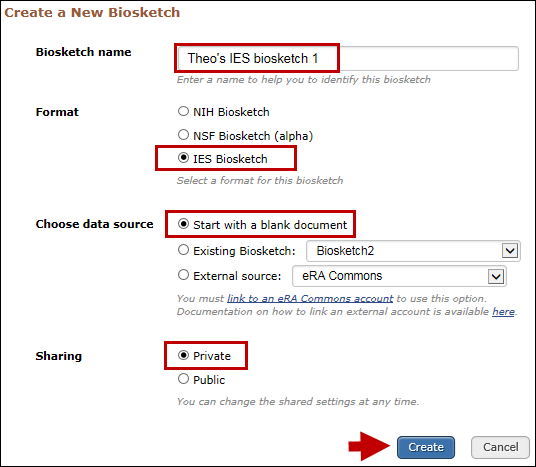
To copy from an existing profile, assign a Biosketch name to the new profile, select the IES Biosketch format option, select "Existing Biosketch" to find and highlight the biosketch you wish to copy, and specify whether to make the new profile public or private. After clicking "Create," SciENcv will generate a duplicate in the IES Biosketch format of the selected existing profile in the IES Biosketch format (see Figure 2).
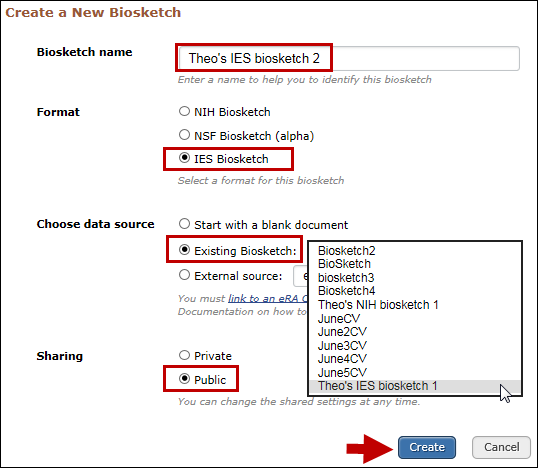
To create a profile from an external data source, assign a Biosketch name to the new profile; select the IES Biosketch format option; select "External Source" to find the data source to populate the new biosketch; and specify whether to make the new profile public or private (see Figure 3). After clicking "Create," SciENcv will populate the new IES biosketch with information stored in your selected external data source. Note that data download, when linked to My NCBI, is possible from three sources: eRA Commons, Open Researcher and Contributor ID (ORCID), and National Science Foundation.
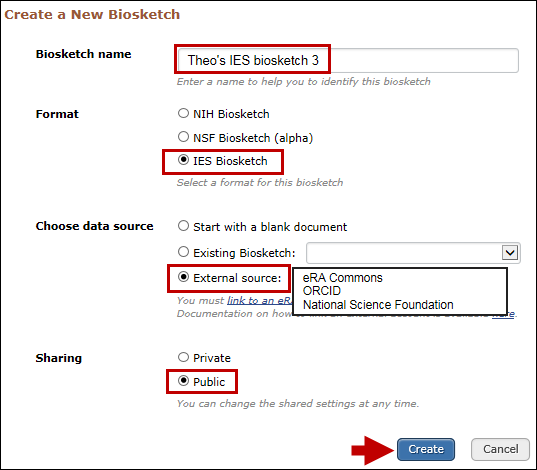
Education and Training
Under Education/Training, enter your academic degrees and training, in chronological order, using the Degree and Training radio buttons. Each entry window has a different set of choices (see Figure 4).
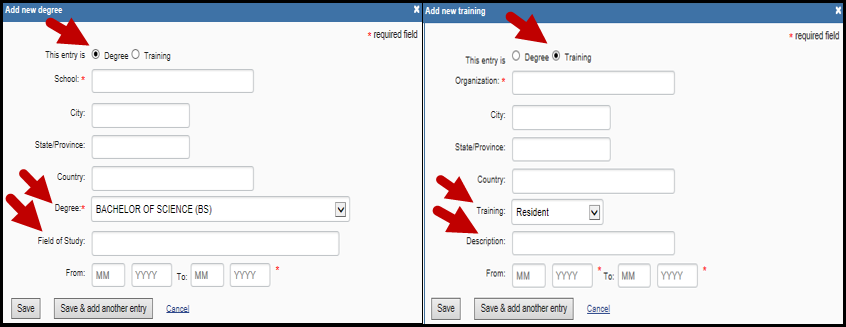
To edit or delete an entry, click "Edit entries" (see Figure 5) and click either "delete" or "edit" next to the selected degree or training entry (see Figure 6). Once you have finished editing, adding, or deleting information, click "Done" to save your updates.
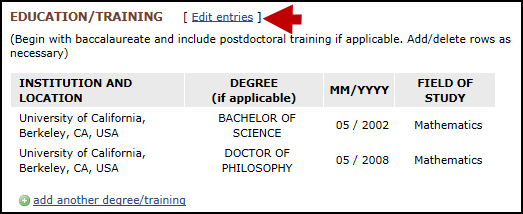
If you want to download or share your profile, but only want selective content to be displayed, uncheck the checkbox next to the entry you would like to hide, and click "Done" (see Figure 6).
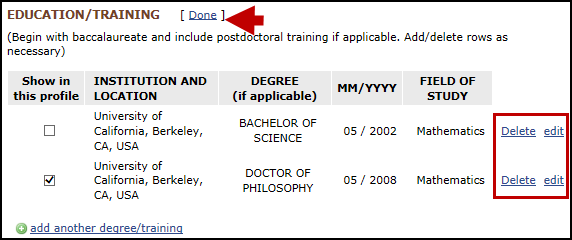
Personal Statement
In the Personal Statement section, enter a brief personal statement and up to four peer-reviewed publications that highlight your work experience and qualifications. To start, click "Edit Statement" (see Figure 7).

Enter your personal statement and click ![]() to save your narrative. SciENcv uses markdown syntax which allows you to add simple formatting to your personal statement. For formatting help, click the
to save your narrative. SciENcv uses markdown syntax which allows you to add simple formatting to your personal statement. For formatting help, click the
![]() icon. Citations stored in My Bibliography can be uploaded initially by clicking the "Select citations" link (see Figure 8). Select up to four citations to be displayed in this section.
icon. Citations stored in My Bibliography can be uploaded initially by clicking the "Select citations" link (see Figure 8). Select up to four citations to be displayed in this section.

In My Bibliography, the default setting for the "Sort by" drop-down menu lists citations by date (newest to oldest). Citations can also be sorted by the first author (alphabetically), or by article title (alphabetically). A link to connect to ORCID is provided and can be used to retrieve citations stored in your ORCID record (see Figure 9).

If your publications are included in the IES ERIC database, you can populate SciENcv biosketches with those citations if they are in My Bibliography. To add citations to My Bibliography, export a file from ERIC or add them manually using My Bibliography templates.
Exporting Citations from ERIC to My Bibliography
In ERIC, enter the full author name or last name and initials in the search box. For example, “Smith, Theodore R.” Or use the ERIC author “field:term” syntax to limit your search to the author field. For example, author: Theodore R. Smith (see Figure 11). To narrow your retrieval to a specific author, select the author name from the Author limiter on the left side of the screen (see Figure 10). Additional information on searching the ERIC database is available in this IES video.
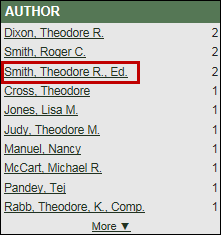
Click “Export” (see Figure 11), select the number of records to include, and click "Create file" (see Figure 11).
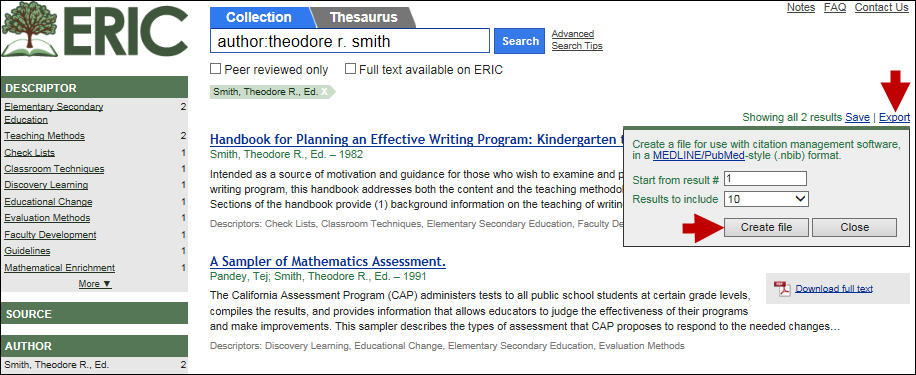
Save the generated file. Sign in to NCBI and click "Manage My Bibliography." In My Bibliography, click "Upload a file" to upload the ERIC citations file you saved (see Figure 12). The citations will display in My Bibliography with a pencil icon, and you will be able to further edit these citations (see Figure 13).
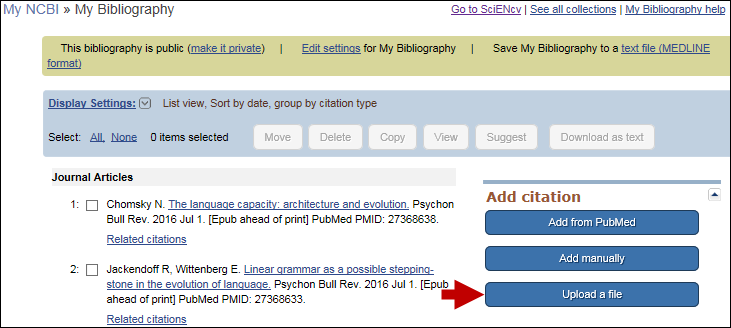
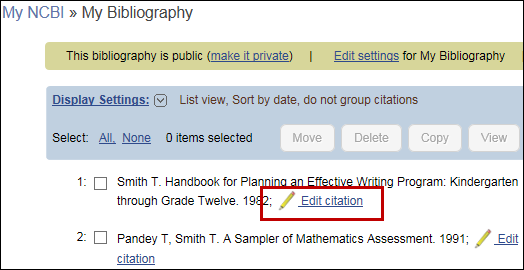
The exported ERIC citations are immediately listed in My Bibliography and can now be selected in SciENcv. Figure 14 shows the Personal Statement section of newly added citations from ERIC to SciENcv via My Bibliography.

Work Experience, Professional Memberships, and Honors
The section titled Positions and Honors consists of three parts: employment, other experience and professional memberships, and honors.
Under the subtitle Employment and positions, enter your past and present employment (see Figure 15). For multiple entries, click "Save & add another entry."
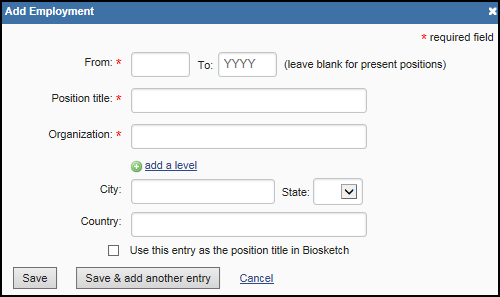
Under the subtitle other experience and professional memberships, enter other work experience and professional memberships (see Figure 16).
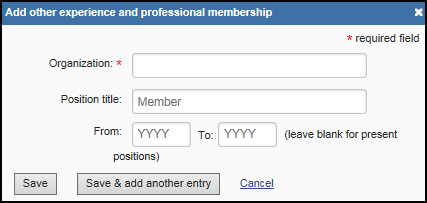
Under the subtitle honors, enter honor society memberships, honorary titles, and other honorary awards (see Figure 17).
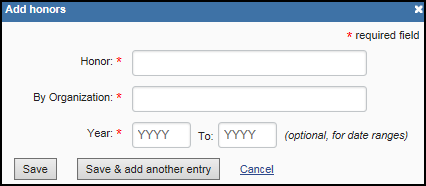
To edit or delete an entry, click either "Delete" or "edit" next to the selected work experience, professional membership, or honor entry. Once you have finished editing, adding, or deleting information, click "Done" to save your updates (see Figure 18).
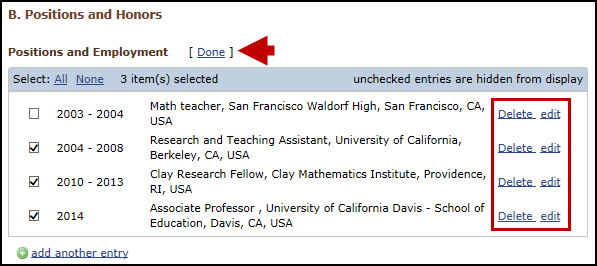
There is an option to hide entries. If you want to print or share your biosketch, but only want selective content to be displayed, unckeck the checkbox next to the entry you would like to hide, and click "Done" (see Figure 18).
Contribution to Education Research
The Contribution to Education Research section provides a place to describe five of your most significant contributions to educational research. Each contribution entry has two parts: a description and relevant references of up to four peer-reviewed publications. To enter a description, click "edit" (see A in Figure 19). To add relevant citations from My Bibliography for each contribution, click "Select citations" (see B in Figure 19).
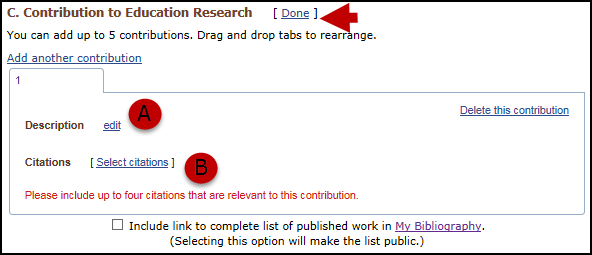
Select up to four citations to be displayed for each contribution. In the My Bibliography tab, the default setting for the "Sort by" drop-down menu lists citations by date (newest to oldest). Citations can also be sorted by first author (alphabetically) or by article title (alphabetically). A link to connect to ORCID is available and can be used to retrieve citations stored in your ORCID record (see Figure 20).

Publications that are included in the IES ERIC database must be added to My Bibliography using an exported file from ERIC (see "Exporting Citations from ERIC to My Bibliography") or added manually using My Bibliography templates.
You can create up to five contribution tabs by clicking "Add another contribution" (see C in Figure 21). Change the display order by dragging and dropping each tab. Contribution tabs can be removed by clicking "Delete this contribution." To save edits, click "Done" (see Figure 21).
There is also an option to include a URL to your My Bibliography collection of published research (see D in Figure 21). Selecting this option would make your My Bibliography collection public.
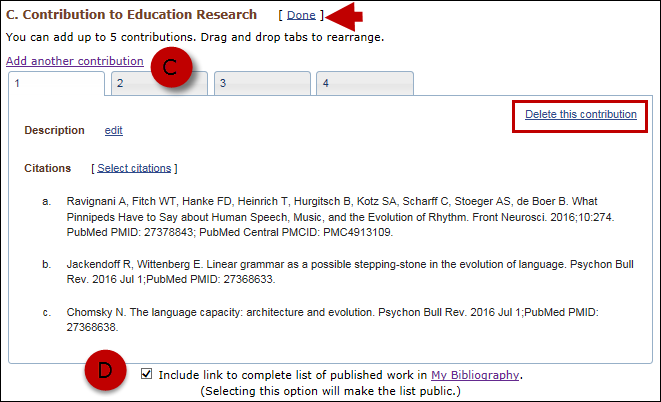
Research Support/Scholastic Performance
The Research Support/Scholastic Performance section displays a list of your ongoing and completed research awards information.
If you linked your ORCID account to My NCBI, your SciENcv profiles will have the research awards included in your ORCID record. Additionally, you have the option to add awards manually if your research awards were not issued by NIH (eRA tab). Select the User tab and click "Add another award" (see Figure 22).
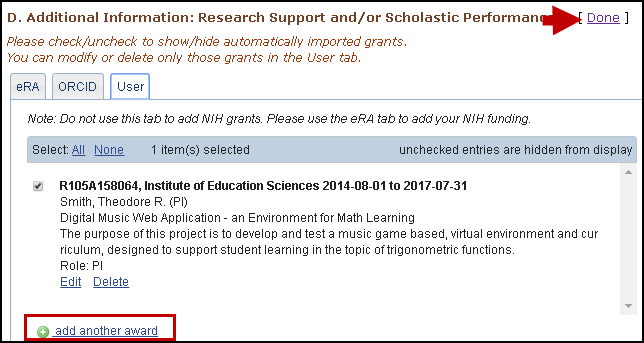
Enter your ongoing and completed research awards. Be sure to select the appropriate category in the "Your Role" drop-down menu (see Figure 23).
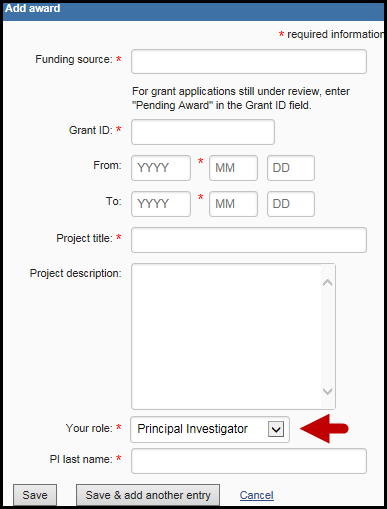
In SciENcv, you can selectively hide the research awards that you wish to omit from the display in your biosketch. Uncheck the box next to the awards you want to hide and click "Done" (see Figure 24).
Hidden research awards will be shown in gray and will not be displayed when a SciENcv biosketch is shared through a URL or printed (see Figure 24).
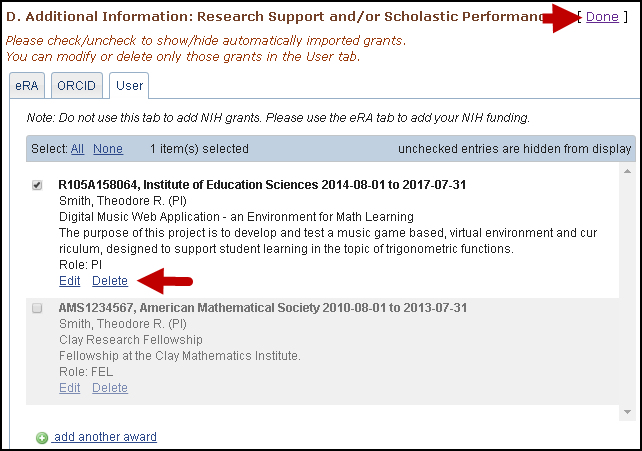
Sharing and Downloading a SciENcv IES Biosketch
SciENcv biosketches are set as private by default; however, a profile can be shared with others through a public URL. Click "Change" (see A in Figure 25) and a URL will be provided. Each biosketch can be independently set up as private or public. SciENcv profiles in the IES biographical sketch format can be downloaded in PDF, MS Word, or XML (see B in Figure 25).

By
Lidia Hutcherson
National Center for Biotechnology Information